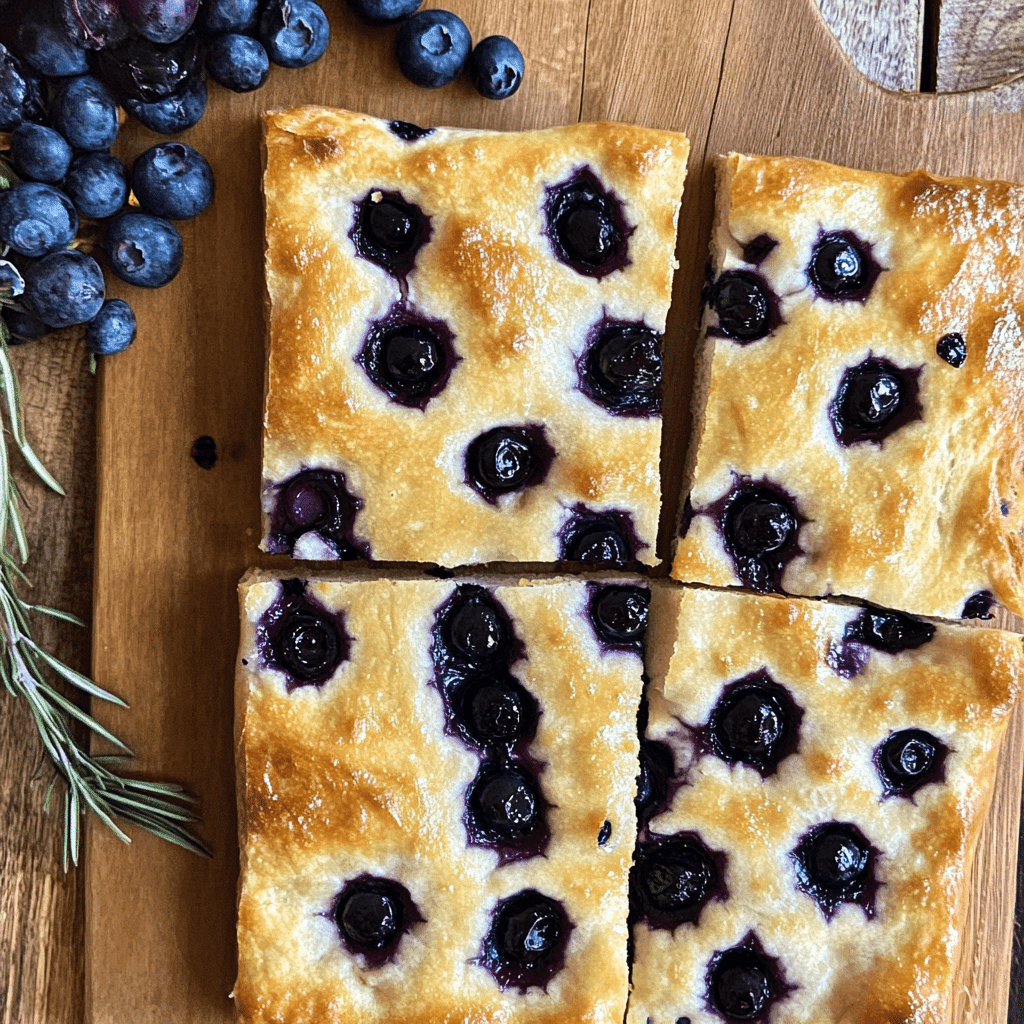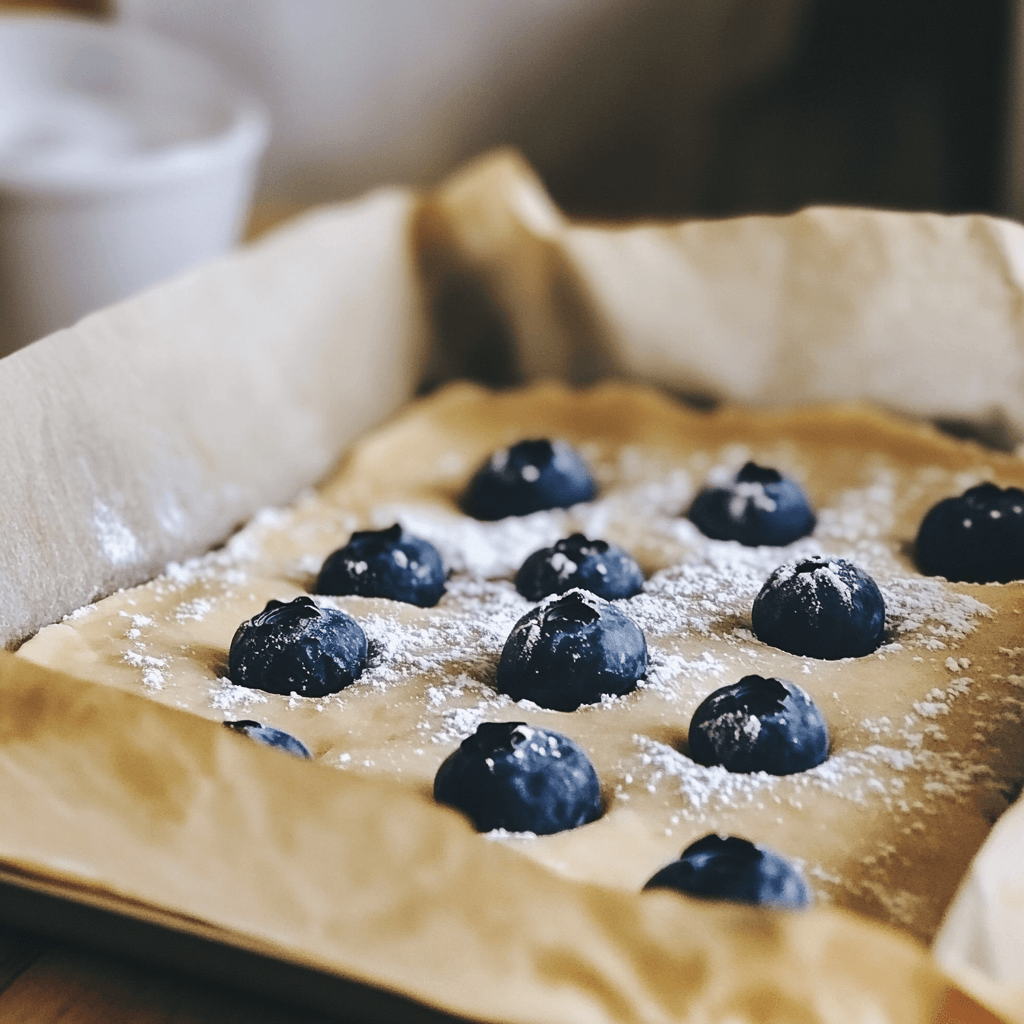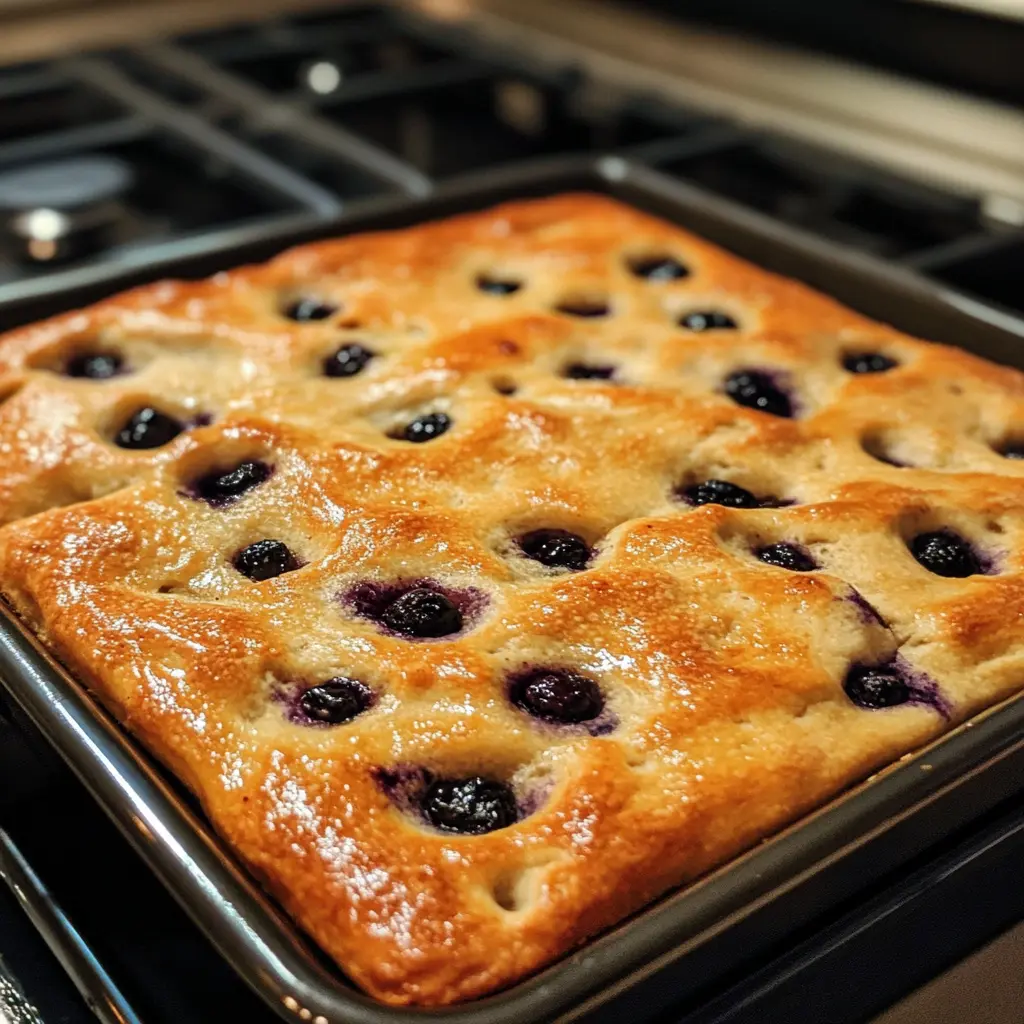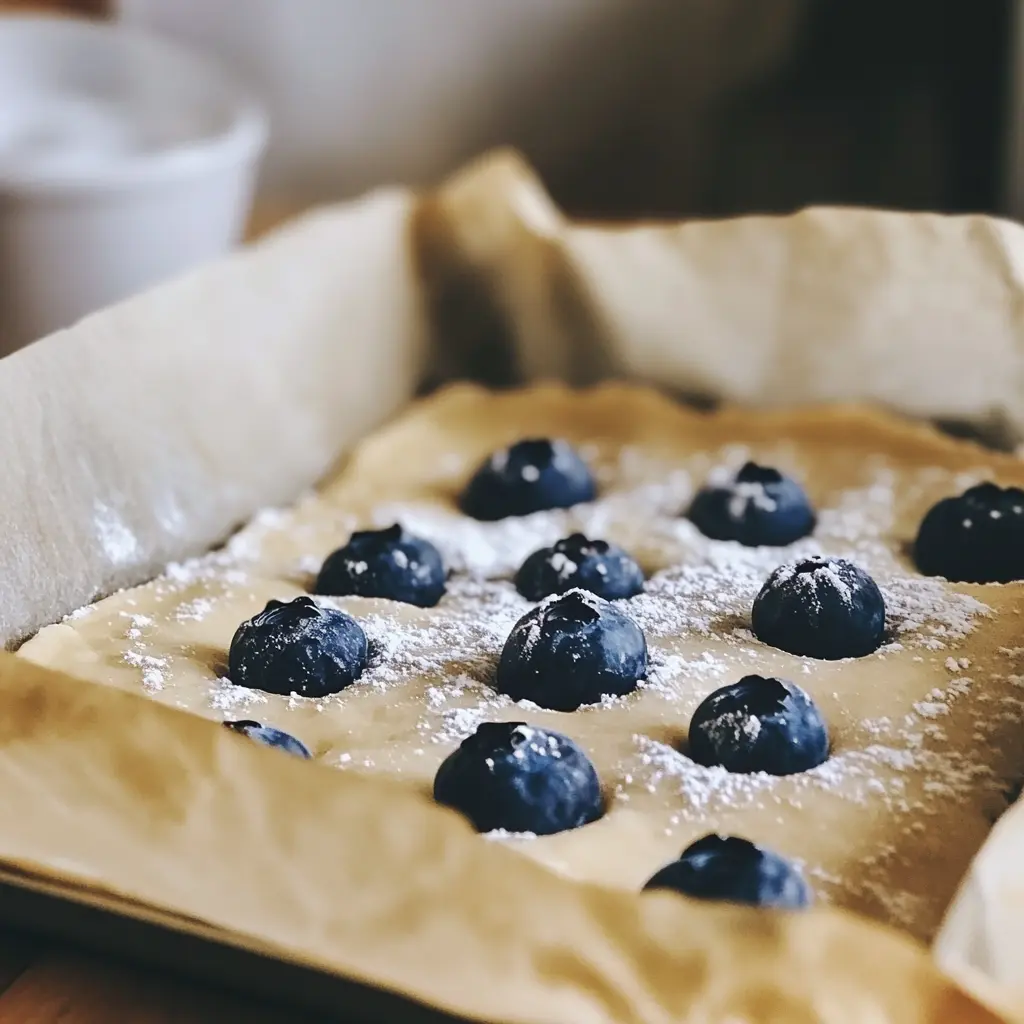Sourdough blueberry focaccia isn’t just a bake—it’s a bold expression of creativity and comfort, and here at Dish RCP, it represents everything we love about food. When we first tested this recipe in our kitchen, we wanted to push the boundaries of what a traditional focaccia could be. Sweet, chewy, tangy, and beautifully vibrant—this bread delivers on all fronts.
Born from the idea of turning familiar ingredients into unforgettable experiences, our version starts with a naturally fermented sourdough base for a deep, developed flavor. Then comes a splash of innovation: dried blueberry powder and blue spirulina, two unexpected heroes that give this focaccia its stunning color and antioxidant punch. But the showstopper? A generous topping of sugar-tossed blueberries that caramelize as they bake, creating a glossy, golden crown over pillowy dough.
At Dish RCP, we believe that baking should be as fun as it is flavorful. This recipe isn’t just for seasoned sourdough lovers—it’s for anyone curious enough to turn simple ingredients into a bakery-worthy masterpiece. Whether you’re hosting brunch, gifting a loaf, or just want to treat yourself, this sourdough blueberry focaccia brings a little magic to every bite.
So, roll up those sleeves. You’re about to learn how to bake one of the most striking and delicious breads you’ve ever seen.

Table of Contents
What Makes Sourdough Blueberry Focaccia So Special?
What Is Focaccia and Why It Matters
Sourdough blueberry focaccia is a classic Italian flatbread known for its chewy texture, crispy edges, and golden crust—often seasoned with olive oil, herbs, and flaky salt. While most versions lean savory, there’s a growing trend of giving this rustic bread a sweet twist, and that’s exactly where sourdough blueberry focaccia comes into play.
The Magic of Adding Blueberries to Focaccia
In this recipe, juicy blueberries aren’t just tossed on top—they become a central flavor component. Their natural sweetness complements the tangy sourdough and adds juicy bursts of flavor with every bite. The caramelization that happens when blueberries are baked with sugar on the focaccia creates a crisp, almost jammy crust that’s hard to resist.
Why We Use Sourdough Instead of Yeast
Opting for sourdough over commercial yeast isn’t just a flavor choice—it’s a health-conscious one too. Sourdough fermentation breaks down gluten more effectively, improves digestion, and gives this focaccia a wonderfully complex taste that standard focaccia just can’t match. Plus, it develops a chewier crumb and a perfectly blistered crust.
Bold Colors, Better Nutrition: Blue Spirulina and Blueberry Powder
What sets this version apart isn’t just the taste—it’s the color. By incorporating blue spirulina and dried blueberry powder into the dough, you don’t just get visual appeal. You also add antioxidants and nutrients. These ingredients offer a subtle fruity undertone while giving the bread an eye-catching purplish-blue hue.
A Fresh, Fun Twist on a Traditional Bake
At its heart, this recipe is about reinventing something familiar into something extraordinary. Whether served at brunch, sliced as a sweet snack, or turned into the most beautiful giftable loaf, sourdough blueberry focaccia is a modern-day showpiece.
Fore more recipes follow me in my pinterest
Print
Sourdough Blueberry Focaccia
- Total Time: 30 hours 25 minutes
- Yield: 1 large focaccia (9×13-inch) – serves 8 to 10 1x
Description
This sourdough blueberry focaccia bursts with juicy berries, which melt into a golden, caramelized base as it bakes. The sweetness of the fruit, the crispy crust, and the signature tang of sourdough come together in perfect balance—sweet, chewy, and irresistibly crunchy.
Ingredients
Dough Base
- 250 Grams Sourdough Starter Freshly Fed is Ideal!
- 520 Grams Bread Flour
- 440 Grams Water
- 16 Grams Salt
- 2 tbs Dried Blueberry Powder Optional, adds a blueberry flavor directly into the dough
- 1 tbs Blue Spirulina Optional, helps make the dough extra blue while adding antioxidants
- 5 tbs Olive Oil Plus extra for lining the parchment paper
Toppings
- 1 ½ Cups Blueberries Fresh or frozen works
- ½ Cup Sugar
Instructions
Prepare the Dough
In a large bowl, combine the sourdough starter, bread flour, water, salt, blueberry powder, and blue spirulina (if using). Mix until the ingredients are fully incorporated into a sticky dough.Initial Rest
Cover the bowl and let the dough rest at room temperature for 30 minutes. This rest allows the flour to fully absorb the water and starts gluten development.Stretch and Fold Method
Over the next two hours, perform a series of four stretch-and-folds—once every 30 minutes. This strengthens the dough without traditional kneading.Bulk Fermentation
After the final fold, cover the dough again and let it rise in a warm spot for 2 to 3 hours, or until it has increased in volume by about 50%.Shape the Dough
Line a baking pan with parchment paper and coat it with 2–3 tablespoons of olive oil. Gently transfer the dough into the pan, using your fingertips to stretch it toward the corners. Be careful not to deflate the dough.Dimple and Oil the Surface
Drizzle 2–4 tablespoons of olive oil over the top of the dough. Using your fingertips, press deeply into the surface to create dimples. These will catch oil and hold the toppings in place.Prepare the Topping
In a small bowl, toss the blueberries with the sugar until evenly coated. Spread the sugared berries over the dough, gently pressing them in. Sprinkle any remaining sugar across the top—this will help form a caramelized crust as it bakes.Cold Proof Overnight
Cover the pan and place it in the refrigerator overnight. This slow fermentation improves the dough’s flavor and structure.Bake from Cold
The next day, preheat your oven to 430°F (220°C). Take the focaccia directly from the fridge and place it into the hot oven—no need to bring it to room temperature. This prevents overproofing and gives the dough a better rise.Bake and Cool
Bake for 20 to 25 minutes, or until the surface is golden brown and the edges look crisp. Remove from the oven, lift the focaccia from the pan, and transfer it to a wire rack to cool completely.
Let It Set Before Slicing
Wait until the focaccia has fully cooled before slicing. Cutting too soon will release steam, which can make the inside gummy.
Notes
Tip: If you enjoy floral flavors, stir 1 tablespoon of dried lavender flowers into the blueberries before adding the sugar. Layer the mixture over the dough for a beautifully fragrant twist—blueberry lavender focaccia is a dreamy upgrade you’ll want to try!
- Prep Time: 1day 6hours
- Cook Time: 25minutes
- Category: Baking, Side Dish, Sides
- Cuisine: American
Nutrition
- Serving Size: 10
- Calories: 339kcal
- Sugar: 14g
- Sodium: 640mg
- Fat: 8g
- Saturated Fat: 1g
- Unsaturated Fat: 1g
- Carbohydrates: 58g
- Fiber: 2g
- Protein: 8g

Ingredients Breakdown for the Perfect Sourdough Blueberry Focaccia
The Dough Base: Building Flavor from the Inside Out
Crafting the ideal sourdough blueberry focaccia begins with a strong, flavorful dough. Each component adds texture, fermentation power, or richness to the final bake:
- Sourdough Starter (250g) – Using a bubbly, active sourdough starter infuses the dough with natural fermentation and signature tanginess that sets sourdough blueberry focaccia apart from conventional breads.
- Bread Flour (520g) – High-protein bread flour forms the strong gluten structure that gives focaccia its airy crumb and chewy bite.
- Water (440g) – Essential for dough hydration, water promotes gluten development and encourages those lovely open pockets in sourdough blueberry focaccia.
- Salt (16g) – Don’t underestimate salt—it enhances flavor and balances the slow fermentation of the sourdough.
- Olive Oil (5 tbsp + extra) – Rich, fruity olive oil adds depth to the crumb and crisps up the edges. It’s used in the dough and generously on the pan for that signature focaccia crust.
Natural Color and Superfood Enhancements
What makes this sourdough blueberry focaccia a visual showstopper? These optional add-ins do double duty—offering vibrant color and health benefits.
- Dried Blueberry Powder (2 tbsp) – Not just a color boost—this ingredient pushes blueberry flavor deeper into the dough, giving every slice an aromatic, fruity depth.
- Blue Spirulina (1 tbsp) – A plant-based superfood, it turns your focaccia dough a stunning shade of blue while offering antioxidants. Your sourdough blueberry focaccia becomes just as nutritious as it is beautiful.
Topping It Off: The Caramelized Blueberry Layer
A crucial part of any blueberry focaccia is what’s on top. These simple ingredients create a glossy, sweet, crunchy topping that’s pure magic.
- Fresh or Frozen Blueberries (1½ cups) – Use what you have on hand. Blueberries burst in the oven and infuse the top layer of the sourdough blueberry focaccia with natural juice and texture.
- Sugar (½ cup) – Coating the berries in sugar helps them caramelize during baking, forming a jammy, golden topping with crisp edges.
Optional Floral Twist: Dried Lavender
Add 1 tablespoon of dried lavender to the sugared berries for an extra layer of aroma. This adds a subtle floral note that transforms your sourdough blueberry focaccia into an artisanal treat perfect for gifting or brunches.
Step-by-Step Instructions for Baking Sourdough Blueberry Focaccia Perfectly
Step 1: Mix the Dough Ingredients
In a large bowl, combine your sourdough starter, bread flour, salt, water, and—if using—blue spirulina and dried blueberry powder. Mix everything until you get a sticky, cohesive dough. There’s no need to knead at this point. Let the dough rest for 30 minutes to allow the flour to fully hydrate.
Step 2: Stretch and Fold for Structure
To strengthen the gluten network and create the classic focaccia rise and texture, you’ll need to stretch and fold the dough.
Do this four times—once every 30 minutes over a 2-hour period. Simply grab one edge of the dough, stretch it up, and fold it over itself. Turn the bowl and repeat from each side. You’ll notice the dough becoming smoother and more elastic with each round.
Step 3: Bulk Fermentation
After the final fold, cover the bowl and let the dough rest at room temperature for another 2–3 hours, or until it has risen by roughly 50%. This step is crucial for flavor development and ensuring your sourdough blueberry focaccia has its signature airy crumb.
Step 4: Prepare the Pan and Shape the Dough
Line a baking pan with parchment paper and pour in 2–3 tablespoons of olive oil. Gently transfer the dough into the pan, stretching it to fit the shape. If it resists, give it 10–15 minutes to relax before stretching again. The olive oil will help crisp the bottom crust—one of the defining features of focaccia.
Step 5: Dimple the Surface
Drizzle 2–4 tablespoons of olive oil on the dough’s surface, then press your fingers into the dough to create dimples. These pockets will hold the olive oil and toppings, giving your sourdough blueberry focaccia that classic textured top.
Step 6: Add the Blueberries
Toss the blueberries in sugar until coated, then gently press them into the dimpled dough. Any leftover sugar should be sprinkled on top—it’ll caramelize into a golden, crunchy crust during baking.
Step 7: Cold Fermentation
Cover the pan and place it in the refrigerator overnight. This slow, cold ferment helps develop deep sourdough flavor and ensures a better rise in the oven.
Step 8: Bake Straight from the Fridge
The next day, preheat your oven to 430°F. Remove the dough from the refrigerator and place it directly into the hot oven—don’t let it warm up first or it may overproof. Bake for 20–25 minutes, or until the top is golden brown and the edges are crisp.
Step 9: Cool Completely Before Slicing
Transfer the baked focaccia to a wire rack and let it cool fully before cutting. Slicing too early releases steam and can make the interior gummy. Trust the process—your sourdough blueberry focaccia will be well worth the wait.

Expert Tips for Perfecting Sourdough Blueberry Focaccia
Feed Your Starter the Right Way
Using a sourdough starter that isn’t fully active is a recipe for disappointment. To ensure a strong rise, feed it well in advance and allow it to become bubbly and airy. A fully matured starter gives your sourdough blueberry focaccia the power to rise with ease and develop rich flavor.
Sticky Dough Is a Good Sign
Don’t be discouraged if your dough feels overly wet. Focaccia doughs thrive on high hydration, which leads to a light, open crumb. To work with it more easily, moisten your hands or apply a small amount of oil during folds and shaping.
Oil Isn’t Optional—It’s Essential
Olive oil is not just for flavor—it also helps create a crispy, golden crust. Make sure to coat both your pan and the top of the dough liberally. This technique adds texture and richness to your sourdough blueberry focaccia and gives it that unmistakable bakery-style finish.
Cold Ferment = Better Bread
Giving your dough a slow rise in the refrigerator overnight enhances both the taste and the internal structure. It allows the sourdough flavors to fully develop while making the dough easier to handle and shape the next day.
Be Bold with Your Dimples
When dimpling, use firm pressure and push your fingertips deep into the dough. Shallow indentations won’t hold olive oil or toppings properly. For a beautifully textured and evenly baked focaccia, deep dimples are key.
Bake Cold for a Stronger Rise
Avoid letting the dough sit out after proofing in the fridge. Cold dough bakes better—it retains its shape and delivers a crispier crust. Place it straight into your preheated oven for best results.
Don’t Overload the Berries
Too many blueberries can make the dough heavy and soggy. Stick to the recommended amount and press them into the dough evenly. Tossing them in sugar before baking adds a glossy, lightly caramelized finish.
Cool It Completely
Though it’s tempting to dig in right away, slicing into hot focaccia can disrupt the crumb and trap steam. Letting your sourdough blueberry focaccia rest on a wire rack allows the interior to set properly.
Top Mistakes to Avoid with Sourdough Blueberry Focaccia
Not Enough Oil → A well-oiled base ensures crispness and flavor.
Weak Starter → Always use a bubbly, doubled-in-volume starter.
Reducing Hydration → Sticky dough is normal and leads to the perfect crumb.
Too Many Toppings → Limit blueberry quantity to avoid sogginess.
Warming Before Baking → Bake cold for better rise and shape.
Shallow Dimpling → Press with confidence for even baking.
Slicing Too Early → Cooling is key for structure and chew.

Flavor Variations and Creative Add-Ins for Sourdough Blueberry Focaccia
One of the best things about making sourdough blueberry focaccia is how adaptable it is. While the basic recipe delivers a delicious, fruit-forward loaf with a golden crust and chewy texture, you can easily switch things up to match your taste or the occasion. Below are some flavorful ideas to take your focaccia to the next level.
Add a Floral Note: Dried Lavender
For a soft, perfumed aroma, mix 1 tablespoon of dried lavender flowers with the sugar before tossing in the blueberries. The combination of floral and fruity makes this version ideal for spring brunches or garden parties.
Pro Tip: Don’t overdo the lavender—too much can overpower the bread’s natural flavor.
Go Herbal: Blueberries + Fresh Thyme or Lemon Zest
Adding fresh thyme brings a subtle herbal contrast that complements the natural sweetness of the blueberries. If you want a touch of brightness, mix lemon zest into the dough or sprinkle it over the top just before baking. These additions bring a more gourmet twist to your sourdough blueberry focaccia.
Try It with Honey Butter Glaze
Want a dessert-style finish? After baking, lightly brush the top of the focaccia with a mixture of melted butter and honey. This creates a glossy, sweet finish that pairs beautifully with the tartness of the blueberries.
Add Crunch with Nuts or Seeds
Sprinkle chopped walnuts, almonds, or sunflower seeds on top before baking. This adds crunch and contrast to the soft, fluffy crumb. Toasted nuts also lend a subtle bitterness that complements the fruit.
Fold Berries into the Dough
Instead of pressing all the blueberries onto the surface, you can fold some into the dough during the final stretch and fold. This technique distributes the berries throughout the focaccia for color and taste in every slice.
Use Different Berries or Fruits
No blueberries on hand? No problem. Swap them with blackberries, raspberries, or even thinly sliced figs or plums. Each variation brings its own texture and flavor profile while keeping the sourdough base intact.
Add a Cheese Element
For a sweet-savory contrast, crumble goat cheese or feta over the top before baking. The tanginess of the cheese blends beautifully with the berries and sourdough.
Make It Vegan or Allergy-Friendly
Use vegan butter instead of dairy for brushing, or eliminate nuts if there’s an allergy concern. The beauty of sourdough blueberry focaccia is that it can flex around dietary needs without losing its charm.

Serving Suggestions and Storage Tips for Sourdough Blueberry Focaccia
Your freshly baked sourdough blueberry focaccia is more than just beautiful—it’s incredibly versatile. Whether you’re serving it at brunch, gifting it, or saving it for later, here’s how to make the most of every slice.
How to Serve It
As a Sweet Brunch Bread
Cut into generous squares and serve it slightly warm with a dollop of whipped butter, honey, or a smear of mascarpone. The balance of tart blueberries, sourdough tang, and soft crumb makes it ideal for breakfast or late-morning gatherings.
With Coffee or Tea
Pair it with a cup of black coffee or a floral herbal tea for a cozy treat. The natural fruit and sourdough flavor contrast perfectly with warm beverages.
As a Unique Dessert
Serve small slices with a drizzle of lemon glaze or a scoop of vanilla ice cream. The chewy texture and subtle sweetness make this a perfect dessert option without being overly rich.
Turn It Into French Toast
Yes, you read that right! Let your sourdough blueberry focaccia go a little stale, slice it thick, and soak it in a custard mix. Fry it up like French toast for a next-level breakfast.
How to Store It
Room Temperature (Short-Term)
To maintain texture for up to 48 hours, wrap the bread in parchment or a towel and place it in a container that limits air exposure. Avoid plastic wrap, which traps moisture and ruins the crust.
Refrigeration (Not Recommended)
Keeping focaccia in the fridge can dry it out and dull its flavor. It’s better to leave it out or freeze it if you’re not eating it right away.
Freezing (Best for Long-Term)
Slice the cooled focaccia into portions and freeze them individually in freezer-safe bags. When you’re ready to enjoy, just toast or warm it in the oven—this brings back the crisp edge and fluffy interior.
Refreshing the Crust
If your focaccia softens after a day or two, pop it in a 375°F oven for 5–7 minutes to revive its crispy exterior.
Final Thoughts on Making Sourdough Blueberry Focaccia at Home
Baking sourdough blueberry focaccia is more than just a fun weekend project—it’s a creative and flavorful way to explore natural fermentation. Whether you’re drawn in by the vibrant colors, intrigued by the mix of sweet and tangy flavors, or simply craving a unique twist on traditional focaccia, this recipe delivers.
With the right ingredients, proper timing, and just a little patience, you can create a bake that’s beautiful enough for a brunch table and satisfying enough to become a repeat favorite. From the chewy sourdough base to the caramelized blueberries on top, every bite offers texture, flavor, and a touch of artistry.
Don’t be afraid to get playful with your flavors. Try lavender, lemon zest, or even goat cheese to take this bread in different directions. And if things don’t go perfectly the first time—like all sourdough projects—it’s part of the learning process.
Get your hands floured, activate your starter, and warm up the oven—it’s time to bake. Your next showstopping bake is just a handful of ingredients away.
Frequently Asked Questions About Sourdough Blueberry Focaccia
Can I use frozen blueberries in sourdough blueberry focaccia?
Yes, you can use either fresh or frozen blueberries. If using frozen, there’s no need to thaw them first. Just toss them with sugar and press them gently into the dough before baking. Keep in mind that frozen berries may release more juice, so don’t overload them.
Why is my focaccia dense and flat?
This usually happens when your sourdough starter wasn’t strong enough, or if the dough didn’t ferment long enough. Make sure your starter is bubbly and active before mixing. Also, allow enough time for the dough to rise by at least 50% during bulk fermentation.
How do I keep the bottom of my focaccia crispy?
The key is olive oil. Make sure the parchment paper is well-coated, and drizzle some oil under the dough before shaping it. Baking at a high temperature (around 430°F) directly from the fridge also helps create a golden, crisp base.
Can I make this recipe gluten-free?
While this specific version relies on gluten for structure, you can experiment with gluten-free sourdough starters and bread flour alternatives like a pre-mixed gluten-free blend. However, expect a different texture and rise.
Is it okay to skip the overnight fermentation?
You can bake the same day, but the results won’t be the same. Cold fermentation deepens flavor and improves the dough’s ability to hold shape. Skipping it can result in less complexity and a softer, less structured crumb.
What’s the best way to reheat leftover focaccia?
Place it in a preheated oven at 375°F for 5–7 minutes to bring back the crispy edges and warm the crumb. Avoid the microwave—it can make the bread rubbery.

